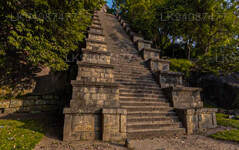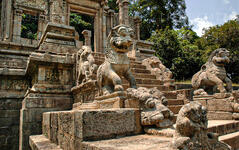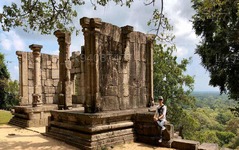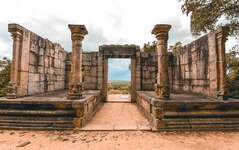
Kurunegala City
Kurunegala: Bustling city in Sri Lanka's North Western Province, featuring historic sites, vibrant markets, and a blend of modern and traditional culture.
Yapahuwa යාපහුව
Yapahuwa (යාපහුව) war eine der kurzlebigen Hauptstädte des mittelalterlichen Sri Lanka. Die Zitadelle von Yapahuwa liegt auf halbem Weg zwischen Kurunegala und Anuradhapura und wurde um einen riesigen Granitfelsen herum erbaut, der sich abrupt fast hundert Meter über das umliegende Tiefland erhebt.
Im Jahr 1272 verlegte König Bhuvenakabahu angesichts der dravidischen Invasionen aus Südindien die Hauptstadt von Polonnaruwa nach Yapahuwa und brachte die Heilige Zahnreliquie mit. Nach dem Tod von König Bhuvenakabahu im Jahr 1284 fielen die Pandyaner aus Südindien erneut in Sri Lanka ein und konnten die Heilige Zahnreliquie erbeuten. Nach der Eroberung wurde Yapahuwa weitgehend verlassen und von buddhistischen Mönchen und religiösen Asketen bewohnt.
Die Festung wurde im Stil der Felsenfestung Sigiriya auf einem riesigen Felsen erbaut. Die Architektur dieser Festung unterscheidet sich jedoch grundlegend von der Sigiriyas: breite Treppen, wunderschöne Steinskulpturen und detailreiche Schnitzereien an den Säulen. Sie können zur Festung hinaufsteigen und die Ruinen der Stupa auf dem Gipfel des Felsens besichtigen. Die Stupa beherbergt einige bemerkenswerte Statuen und Bilder aus der Kandy-Ära, die Sie bewundern können.
About Kurunegala District
Kurunegala is the capital of the Wayamba Province in Sri Lanka and the Kurunegala District.Kurunegala was a royal capital for only 50 years, from the end of the 13th century to the start of the next, though even before this it was strategically placed in the middle of other majestic strongholds such as Yapahuwa to the north, Dambadeniya to the south and Panduwasnuwara in the east. Ethagala a rock reaching 316 meters, towers over the town, which is located at an altitude of 116 meters above sea level. The shape of Ethagala resembles an Elephant. A transport hub, it has a railway station, and several main roads linking important parts of the country.Kurunegala is situated about 94 km from Colombo, and 42 km from Kandy.
Most of Kurunegala's residents belong to the Sinhalese majority. Other ethnic minorities include the Sri Lankan Moors, Sri Lankan Tamils, Burghers and Malays. Residents from ethnic minorities live in all parts of the city, however, sizeable communities of Moors and Tamils also live in the areas of Teliyagonna and Wilgoda.
About North Western Province
North Western Province is a province of Sri Lanka. The districts of Kurunegala and Puttalam formulate North Western or Wayamba. Its capital is Kurunegala, which has a population of 28,571. The province is known mainly for its numerous coconut plantations. Other main towns in this province are Chilaw (24,712) and Puttalam (45,661), which are both small fishing towns. The majority of the population of Wayamba province is of Sinhalese ethnicity. There is also a substantial Sri Lankan Moor minority around Puttalam and Sri Lankan Tamils in Udappu and Munneswaram. Fishing, prawn farming and rubber tree plantations are other prominent industries of the region. The province has an area of 7,888 km² and a population of 2,184,136 (2005 calculation).
Wayamba is the third largest paddy producing area in Sri Lanka .Wayamba has a highly developed agricultural economy, growing a variety of fruits and vegetables, flowering plants, spices, oil-seeds in addition to the traditional plantation crops such as Coconut, Rubber and Rice. Rich soils and varied climate give Wayamba a potential for growing of virtually any crop.
In Wayamba or North western province, home for ancient Buddhist rock temples, magnificent citadels Panduwasnuwara, Dambadeniya, Yapahuwa and Kurunegala. Impressive remains of those citadels, palaces, Buddhist temples and monasteries provide exciting sight seeing to the visitors.













